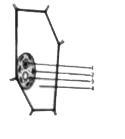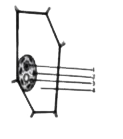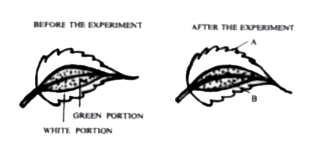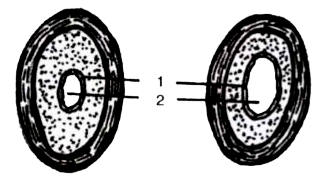Complete Solutions to SECTION-II of chapter SAMPLE PAPER 2012 of Class 10 book with complete answers and questions
| Class 10 | BIOLOGY |
| Chapter | SAMPLE PAPER 2012 |
| GURUKUL | SECTION-II |
| Number Of Questions | 57 |
| Academic Year | 2023-24 |
Given below is an experimental set-up to demonstrate a particular process. Study the same and answer the questions that follow :

Name the physiological process being studied.
View SolutionGiven below is an experimental set-up to demonstrate a particular process. Study the same and answer the questions that follow :

Explain the process being studied.
View SolutionGiven below is an experimental set-up to demonstrate a particular process. Study the same and answer the questions that follow :

What is the aim of the above experiment ?
View SolutionGiven below is an experimental set-up to demonstrate a particular process. Study the same and answer the questions that follow :

What would you observe in the experimental set up after an hour? Give a reason to support your answer.
View SolutionGiven below is an experimental set-up to demonstrate a particular process. Study the same and answer the questions that follow :

Mention any three adaptations found in plants to overcome the physiological process mentioned in being studied.
View SolutionGive technical term for:
A membrane which allows the passage of molecules selectively.
View SolutionGive biological/ technical terms for the following:
The suppressed allele.
View SolutionGive technical term to the following:
The structure that carries visual stimuli from retina to the brain.
View SolutionGive biological technical terms for the following
Squeezing out of white blood cells from the capillaries into the surrounding tissues,
View SolutionGive technical term to the following:
Protective membranes covering the human brain and spinal cord.
View SolutionGive technical term to the following:
Eye lens losing flexibility resulting in a kind of long-sightedness in elderly people.
View SolutionGive technicallbiological term for the following:
(I) Hormone which stimulate other endocrine glands to produce their specific hormones.
View SolutionGive technical term :
The phase in the menstrual cycle in which the remnant of follicle in the ovary turns into corpus luteum.
View SolutionGive biologicaVtechnical term for the following
Statistical study of human population.
View SolutionGive the biological terms for each of the following:
Introduction of weakened germs into the body to develop resistance against a disease.
View SolutionGiven alongside is the diagram of a cell as seen under the microscope after being placed in a solution.

What technical term is used for the state/ condition of the cell given ?
View SolutionGiven alongside is the diagram of a cell as seen under the microscope after being placed in a solution.

Name the parts numbered 1-4.
View SolutionGiven alongside is the diagram of a cell as seen under the microscope after being placed in a solution.

Name the parts numbered 1-4.
View SolutionGiven alongside is the diagram of a cell as seen under the microscope after being placed in a solution.

Is the cell given above plant cell or animal cell ?
Give two reasons in support of your answer as evident from the diagram.
View SolutionGiven alongside is the diagram of a cell as seen under the microscope after being placed in a solution.

Name the parts numbered 1-4.
View SolutionDifferentiate between the following pair on the basis of what is mentioned within bracket.
Natality and mortality (definition).
View SolutionDifferentiate between the following pairs as directed in the brackets
Stoma and stroma (structure)
View SolutionDifferentiate between the following:
Acromegaly and Cretinism (symptoms)
View SolutionDifferentiate between the following:
Guttation and transpiration
View SolutionDifferentiate between the following pairs on the basis of what is mentioned in brackets :
Diabetes mellitus and Diabetes insipidus (reason/cause)
View SolutionThe diagram given below represents an organ system in the human body. Study the same and answer the questions that follow:

Identify the system.
View SolutionThe diagram given below represents an organ system in the human body. Study the same and answer the questions that follow:

Identify the system.
View SolutionThe diagram given below represents an organ system in the human body. Study the same and answer the questions that follow:

Identify the system.
View SolutionBriefly explain the following physiological processes:
Significance of osmosis
View SolutionBriefly explain the Allele
View SolutionExplain briefly :
Pulse.
View SolutionExplain the term Reflex action.
View SolutionAn electrical synapse differs from a chemical synapse in that the electrical synapse :
View SolutionStudy the diagram given below and then answer the questions that follow :

(i) Name the part labelled A. Name any two hormones produced by the part labelled A.
(ii) What happens to the part labelled B if :
(1) fertilisation takes place?
(2) fertilisation does not take place ?
(iii) Where does fertilisation occur ?
(iv) Draw a neat diagram of the human sperm as seen under high magnification and label the following parts: (a) Acrosome (b) Mitochondria.
View SolutionStudy the diagram given below and then answer the questions that follow :

(i) Name the part labelled A. Name any two hormones produced by the part labelled A.
(ii) What happens to the part labelled B if :
(1) fertilisation takes place?
(2) fertilisation does not take place ?
(iii) Where does fertilisation occur ?
(iv) Draw a neat diagram of the human sperm as seen under high magnification and label the following parts: (a) Acrosome (b) Mitochondria.
View SolutionStudy the diagram given below and then answer the questions that follow :

Where does fertilization occur ?
View SolutionStudy the diagram given below and then answer the questions that follow :

(i) Name the part labelled A. Name any two hormones produced by the part labelled A.
(ii) What happens to the part labelled B if :
(1) fertilisation takes place?
(2) fertilisation does not take place ?
(iii) Where does fertilisation occur ?
(iv) Draw a neat diagram of the human sperm as seen under high magnification and label the following parts: (a) Acrosome (b) Mitochondria.
View SolutionA homozygous plant having round (R) and yellow (Y) seed is crossed with a homozygous plant having wrinkled (r) and green (y) seeds.
Give the scientific name of the plant on which Mendel conducted his hybridization experiments.
View SolutionA homozygous plant having round (R) and yellow (Y) seed is crossed with a homozygous plant having wrinkled (r) and green (y) seeds.
Give the genotype of `F_1` generation.
View SolutionA homozygous plant having round (R) and yellow (Y) seed is crossed with a homozygous plant having wrinkled (r) and green (y) seeds.
Give the dihybrid phenotypic ratio and the phenotype of the offspring of the `F_2` generation when two plants of the `F_1` generation are crossed.
View SolutionA homozygous plant having round (R) and yellow (Y) seed is crossed with a homozygous plant having wrinkled (r) and green (y) seeds.
Name and state the law which explains the dihybrid ratio.
View SolutionA homozygous plant having round (R) and yellow (Y) seed is crossed with a homozygous plant having wrinkled (r) and green (y) seeds.
Give the possible combination of gametes that can be obtained from `F_1` hybrid.
View SolutionThe diagram given below is an experiment conducted to study a factor necessary for photosynthesis Observe the diagram and then answer the following questions

What is the aim of the experiment
View SolutionThe diagram given below is an experiment conducted to study a factor necessary for photosynthesis Observe the diagram and then answer the following questions

Name the test performed on the leaf and the solution used for the test
View SolutionThe diagram given below is an experiment conducted to study a factor necessary for photosynthesis Observe the diagram and then answer the following questions

What type of leaf was used for the experiment? Give an example
View SolutionThe diagram given below is an experiment conducted to study a factor necessary for photosynthesis Observe the diagram and then answer the following questions

What is the expected result of the above test on the parts labelled A and B ?
View SolutionThe diagram given below is an experiment conducted to study a factor necessary for photosynthesis Observe the diagram and then answer the following questions

Give a balanced chemical equation to represent the process of photosynthesis
View SolutionThe diagrams given below show the cross-section of two kinds of blood vessels :

Name the parts numbered 1 and 2
View SolutionThe diagrams given below show the cross-section of two kinds of blood vessels :

Name the parts numbered 1 and 2
View SolutionThe diagrams given below show the cross-section of two kinds of blood vessels :

When are the sounds "LUBB" and "DUP produced during a heartbeat?
View SolutionThe diagrams given below show the cross-section of two kinds of blood vessels :

Name the blood vessel that
(1) begins and ends in capillaries
View SolutionDraw a well labelled diagram of a 'Neuron' and name the following parts: Node of Ranvier
View SolutionName the following: The parts of human brain concerned with
(a) seat of memory (b) coordinates muscular activity.
View SolutionList any two activities of WHO.
View SolutionDraw a well labelled diagram of metaphasic chromosome.
View SolutionAnswer the following questions briefly.
List two reasons for the population explosion in India.
View SolutionWhy is pituitary gland called the "master gland" ?
View Solution
SECTION-II questions and complete solutions for chapter SAMPLE PAPER 2012 of EVERGREEN BIOLOGY (ENGLISH) of Class 10